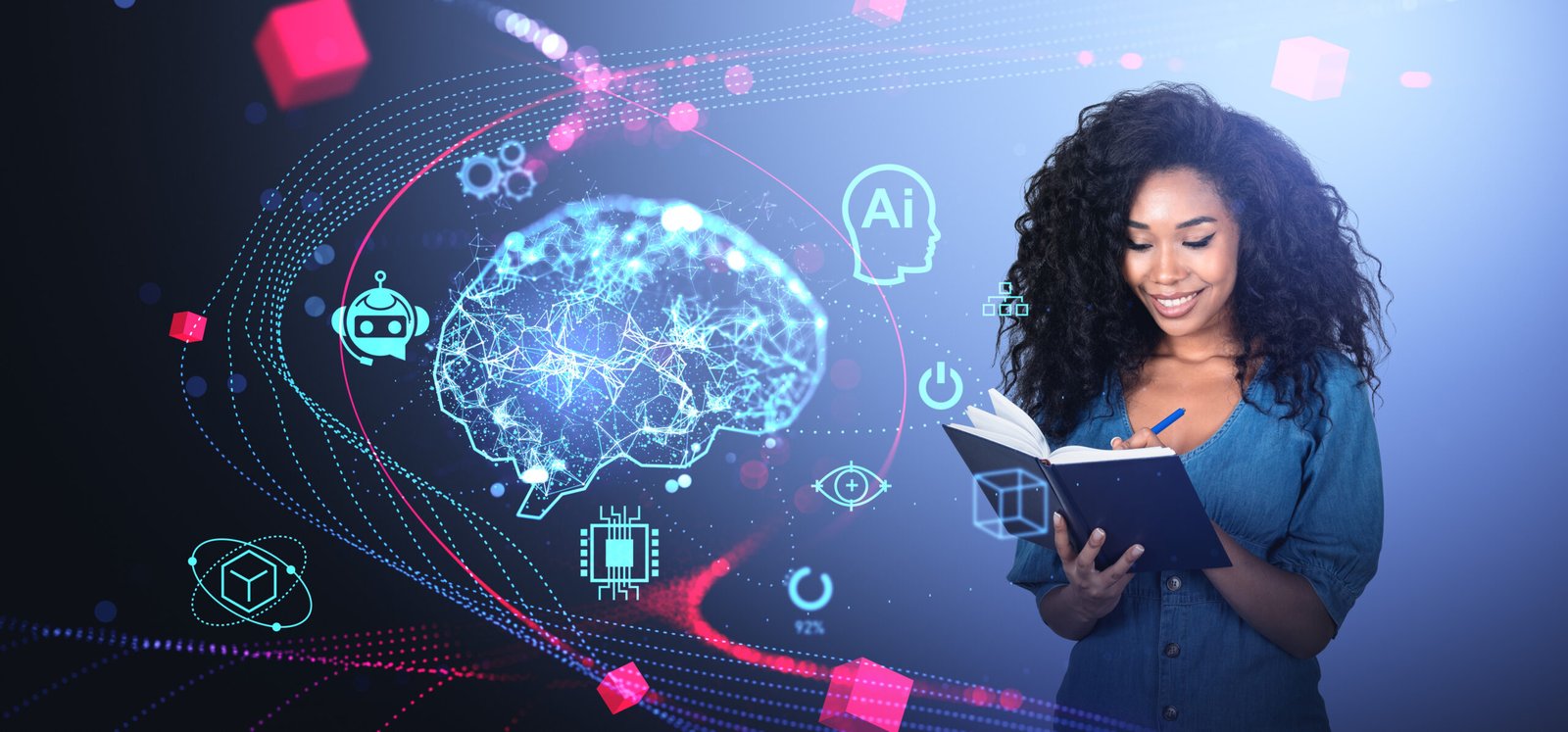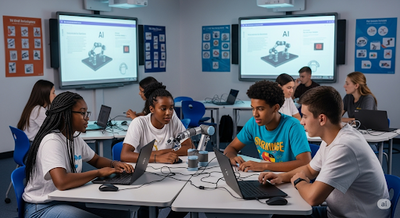Education
Artificial Intelligence and Critical Thinking in Higher Education: Fostering a Transformative Learning Experience for Students – Faculty Focus

Education
I toured UK council estates and learned this: all our lives are poems just waiting to be written | Rowan McCabe

When I first suggested knocking on strangers’ doors and offering to write a poem for them, for nothing, on any subject of their choosing, the responses weren’t exactly enthusiastic. I’m from Heaton in Newcastle upon Tyne, where the project began. One day, I happened to mention it to a taxi driver as I travelled through Byker, near Newcastle city centre. “It would never work round here,” he said, pointing out of the window.
The building he was pointing to was the Byker Wall, an estate near where I live – I’ll admit it’s not the first place you’d visit on the hunt for a bard. When I told my friends and colleagues that I was planning to try Door-to-Door Poetry here, they all made exactly the same sound – a Marge Simpson-esque expression of unease. I mentioned it to a trainee police officer who lived close to me. “Take some pepper spray and don’t carry any valuables,” she advised soberly. Having grown up on a council estate myself, I wasn’t as apprehensive as I might have been. But warnings like this still did a lot to rattle my nerves.
When I arrived at the Byker Wall, the first person to answer was a man called Carl. He had bright blue eyes, a peaked baseball cap, and was wearing a Newcastle shirt. I performed an introductory poem for him while he stared back at me, completely expressionless. When I got to the end, I explained I could write him a poem about anything he wanted.
“So what is important to you?” I asked. “Getting wrecked,” Carl replied. I could tell from the off that this was a “testing the boundaries” thing. I told Carl I would be more than happy to write a poem for him about getting wrecked. Whatever was important to him, really.
Something in his face changed. “Will you write me one about how much I love my girlfriend?” he said. The conversation had gone from hardcore to sentimental in about three seconds.
I wrote a poem for Carl about his and his partner’s first date. He told me he really enjoyed it. He was one of seven people who asked for a poem in the Byker Wall estate. And it was this hugely positive experience that set me off on a journey, one that would introduce me to a great many more residents in social housing and council estates across the land.
In Boston, Lincolnshire, which has been dubbed England’s “most divided” town, I met five people on a street called Taverner Road. One of them was a woman named Pauline, who asked for a poem about “banger racing”, a sport that involves souping up secondhand cars and then crashing them into each other at great speed. I didn’t know anything about banger racing until that point, so the next day I went to watch some at Skegness Raceway before writing Pauline’s poem.
On an estate in Moss Side, Manchester, I met a man who asked to be referred to as “the specialist”. I showed him my introductory poem and he shook my hand. “You’ve come to the right place,” he said. He told me what I was doing was freestyle, in the true sense of the word, before explaining that I resembled an 18th-century time traveller. I wrote him a poem about that.
I visited estates across the country, and the response was always the same. Whether people were existing fans of poetry or not, so many of them stopped to listen, to chat about their lives and to gratefully receive the resulting poem.
Towards the end of my adventures, in Jaywick, Essex – often described as the “most deprived town” in England – I met Sarah, a woman with red hair and tattoos on her arms. She lamented the fact that the media only seemed to visit Jaywick to write a terrible story about it, and asked for a poem about its best side instead. This request led me to discover the beautiful beaches, as well as a fantastic fish and chip shop called Ozzy’s.
The whole experience got me thinking about why we write poetry and who it is really for. In a world in which poetry is still seen by many as opaque and inaccessible, we discuss innovative ways to engage people with it. But it seems to me that another, more important issue is who we imagine will read the poem when it is finished. And how we want them to feel once they have.
Trying my Door-to-Door Poetry on a range of estates forced me to question some of my own preconceptions. It invited me to consider the fact that, in any given place, there is always a wide variety of people; that when we take the time to get to know someone, especially someone who lives their life differently to us, we are often embarking on a journey of self-discovery too. In a world that can feel increasingly divided and polarised, I am grateful to have had the chance to learn this – from house to house, poem to poem and door to door.
On Visiting Jaywick
Yes, Jaywick, I’ll confess my reservations.
Your name I’d heard, your headlines I had read.
I took the bus, explained my destination,
The driver fixed me with a look of dread.
But on that evening, walking on your beach,
The sky was clear, the sun bobbed on the waves,
The soft and golden sand was at my feet,
Dog walkers smiled and went about their day.
And honestly? It took me by surprise,
Your natural beauty shook away my blues,
I couldn’t help but pause and wonder why
This scene had never featured on the news.
For certain as each summer fades to brown,
The tabloids yearly come here for a snap
Of what they’ve dubbed a run-down, worthless town
(Though who’s in charge of it, they never ask).
They hunt for weeds and windows that need fixed,
They hover round like poachers in the road,
But do they stay for views as grand as this
Before they pen their articles of woe?
Because I know you have your problems, Jaywick.
But people here are welcoming and kind.
And Ozzy’s does the perfect fish and chips,
Next to a pub that’s called Never Say Die.
But that won’t make the front page, nor the sea
As it glitters here above your coastal shelf,
When papers only deal in misery,
I’m pleased I found the truth out for myself.
Education
AI and Education – Future resilience

The risks and realities of AI use in education
Meanwhile, emerging research suggests that habitual (over)use of AI tools to complete assignments can cause significant harm to their intellectual capabilities. The most significant concern involves potential atrophy of precisely those skills that remain uniquely human and increasingly valuable.
Students who consistently rely on AI to perform cognitive tasks may lose the ability to perform these tasks independently, creating dependency that extends into professional environments where creative thinking, analytical reasoning, and adaptive leadership prove essential. Understanding these risks becomes crucial when education correctly emphasizes future-relevant capabilities.
Critical thinking deteriorates
When students bypass cognitive effort by relying on AI-generated content for tasks requiring original analysis, they reduce their capacity for independent reasoning and evidence evaluation. This risk becomes particularly acute when assignments properly focus on developing analytical thinking – one of the core 2030 skills signaled by the WEF. Students who consistently use AI to formulate arguments or analyze complex problems often miss necessary practice in logical reasoning, resulting in learners who struggle to distinguish credible information and lack the analytical skills required for academic and professional success.
Creativity and originality decline
Heavy AI dependence can diminish creativity and originality by removing the struggle and exploration that creative thinking requires. Since creative thinking represents perhaps the most essential core skill for 2030, this deterioration proves especially problematic. AI circumvents the vital process of wrestling with problems, revising, and iterating original ideas that support cognitive development. Students may become accustomed to AI-generated ideas and lose confidence in their creative capabilities, missing the iterative process of brainstorming, failing, and refining that builds creative resilience.
The illusion of knowledge increases
Dependence on AI-generated solutions creates an illusion of competence rather than genuine capability development. Students may appear proficient due to polished AI-generated responses, but they may lack authentic mastery of analytical thinking, creative problem-solving, or other core skills. This superficial competence can mask significant learning gaps, as students perform well on AI-assisted assignments but struggle when required to demonstrate capabilities independently.
Education
AI in Education in Australia: The Future of Learning

- AI is revolutionizing Australian education by personalizing learning experiences, automating administrative tasks, and enhancing student engagement.
- National frameworks are driving responsible AI integration, ensuring that technology aligns with student safety and educational goals
- AI-powered tools like chatbots and adaptive learning systems are helping students and teachers boost productivity and learning outcomes.
- AI literacy initiatives like ‘Day of AI Australia’ are equipping students and teachers with essential AI skills for future success.
You’ve probably noticed it too – AI isn’t just tech news anymore. It’s happening right here in Australian classrooms, and it’s changing everything about how education works. Whether you’re running a university, managing a TAFE, or leading a private college, AI reshaping education in Australia is likely already on your radar.
Maybe you’re seeing it in small ways – adaptive learning platforms that actually seem to “get” your students, or administrative tasks that suddenly don’t eat up your staff’s entire day. Perhaps you’re hearing from colleagues about the insights they’re getting from their data, insights that are helping them make decisions they never could before.
Here’s what’s interesting though: the institutions seeing real success aren’t just buying AI software and hoping for the best. They’re thinking bigger picture – how does this fit with our teaching philosophy? What does it mean for our students’ privacy? How do we make sure this actually improves learning, not just creates more digital noise?
And honestly, that’s where the real opportunity lies. Because while everyone’s talking about AI, not everyone’s implementing it thoughtfully. The institutions that get artificial intelligence in education in Australia right – really right – aren’t just keeping up with trends. They’re setting the pace for what Australian education looks like in the years ahead.
So where does your institution sit in all this?
Top educational leaders across Australia are reshaping learning with AI-driven strategies. Where does your institution stand in this shift?
Also Read: AI in Australia (Implementation and Opportunities)
Australia’s Approach to AI in Schools: What Data Reveals
Australia is demonstrating a remarkably proactive and strategic approach to integrating Artificial Intelligence within its education system. For sector leadership, recent insights offer genuinely compelling perspectives on AI for education in Australia. A key development involves the 2024 Review of the Australian Framework for Generative AI in Schools, formally endorsed by Education Ministers just last month.
This national framework, initially launched in October 2023, undergoes annual reviews to keep pace with rapid technological evolution. This demonstrates sustained commitment to the responsible development of AI education solutions in Australia.
- 2024 Review Affirmed Framework’s Foresight: Recognized its ability to anticipate emerging AI risks, like deepfakes, etc.
- Collaborative Development: Created by the National AI in Schools Taskforce with input from all jurisdictions.
- Evidence-Informed Methodology: Incorporates best practices for AI implementation in education.
- Australia’s Strategic Intent: Creates a framework for artificial intelligence in education that balances innovation leadership with ethical implementation.
Must Read: Navigating Responsible AI Principles
Australia’s engagement with AI-powered education is rapidly progressing beyond national frameworks into tangible, classroom-level innovation. While overarching policy guides ethical deployment, new data reveals a deeper integration and focused efforts on practical application.
Concurrently, nationwide efforts like ‘Day of AI Australia’ are significantly boosting AI literacy, demonstrating the growing synergy between AI and edtech in Australia. This program, now reaching over 100,000 students and educators, offers free, hands-on learning experiences, equipping young Australians (Years 1-10) with foundational AI skills crucial for future readiness. Teacher confidence is also being addressed through new online professional learning modules, a collaboration between Education Services Australia (ESA) and Microsoft.
7 Success Stories of AI Reshaping Education in Australia Along with Business Benefits
AI in education in Australia is undergoing an exciting shift. Artificial Intelligence is transitioning from a theoretical possibility to a practical reality. Educational leaders nationwide are now focused on measurable results for AI for education rather than conceptual potential, and the outcomes are genuinely promising.

The below use cases and case studies demonstrate how strategic AI integration isn’t just about innovation for its own sake but about creating genuine value for students, teachers, and institutions.

South Australia’s ‘EdChat’ AI Tool for Government Schools
South Australia’s Government Schools Students now have their own AI tutoring assistant, like ‘EdChat’ tool, which helps them dive deeper into their coursework. This tool shines in English, Science, and Math classes, plus it’s a game-changer for kids who struggle with language or learn differently. What caught everyone’s attention? Nearly all student conversations with the system, 94% to be exact, focused on schoolwork rather than off-topic chatter, reveals Teacher Magazine.
The results from early testing show that students aren’t just using this technology for entertainment. They’re genuinely engaging with their curriculum in ways that feel natural to them. For students who might normally feel left behind due to language barriers or learning differences, having this patient digital partner makes a real difference in how they connect with their studies.
What You Can Do: For your institution, implementing a similar AI tutoring system offers multiple strategic advantages:
- Cost Reduction: Significantly cut student support costs by reducing dependency on additional tutoring staff and remedial programs
- 24/7 Support: AI handles initial student queries and provides personalized assistance around the clock, improving student satisfaction
- Proven Engagement: The 94% on-task engagement rate ensures productive use of technology resources
- Performance Impact: Direct improvements to your institution’s academic performance metrics and student satisfaction scores
This approach gives you confidence in deployment while delivering measurable ROI through both cost savings and enhanced learning outcomes.
Boosting Teacher Confidence via ESA & Microsoft Professional Learning
Teachers are finally receiving the support they’ve been requesting through new online training that addresses their genuine concerns about incorporating AI for education in Australia into the classroom. These modules don’t just present theory to educators – they provide hands-on guidance that helps teachers feel genuinely confident about incorporating AI tools into their daily teaching routines safely and effectively.
The early numbers tell a compelling story: teachers could potentially reclaim over 9 hours each week by letting AI handle routine paperwork, grading basic assignments, and managing administrative tasks. That’s essentially getting back more than a full workday every week. For most educators already stretched thin, this kind of time savings (9.3 hours per week) means less evening work at home and more energy for what drew them to teaching in the first place – actually connecting with students and creating meaningful learning experiences.
What You Can Do: For your institution, this represents a direct opportunity to improve staff retention and reduce burnout-related costs:
- Ready-Made Training: Leverage AI training to upskill your teaching staff without building internal programs from scratch
- Workforce Efficiency: Teachers saving 9+ hours weekly on administrative tasks effectively increases your workforce capacity without hiring additional staff
- Retention Benefits: Simultaneously improve job satisfaction and reduce the expensive cycle of teacher turnover that plagues many educational institutions
This strategic approach delivers immediate operational improvements while addressing long-term staffing challenges that impact your bottom line.
National AI Literacy via ‘Day of AI Australia’
This ambitious nationwide program is making real headway in getting both students and teachers comfortable with AI technology through practical, hands-on experiences that don’t cost schools a penny. The scale is impressive – they’re targeting over 100,000 students and educators across years 1 through 10, representing a massive commitment to preparing Australia’s future workforce.
What’s smart about this approach is that it includes educators alongside students, ensuring teachers can confidently guide these conversations in classrooms long after the initial training ends. This type of early investment in AI in schools in Australia makes sense when considering how expensive it becomes to retrain workers later if they lack fundamental digital skills. The program recognizes that AI literacy is no longer a luxury – it’s becoming as essential as basic computer skills were a generation ago.
What You Can Do: Instead of participating in existing programs, develop a custom AI literacy platform for your institution:
- Custom Learning Platform: Build an AI-powered system tailored to your curriculum and teaching methods, similar to leading Australian edtech solutions
- Proprietary Training Modules: Create institution-specific AI literacy programs that align with your academic standards and values
- Data Ownership: Maintain complete control over student learning analytics and insights, unlike external programs
- Revenue Opportunity: License your platform to other institutions, creating additional income while establishing thought leadership
- Scalable Growth: Develop a system that evolves with your needs, incorporating automated assessments and personalized learning paths
University Staff AI Adoption & Productivity Gains (National Study)
The numbers from higher education are eye-opening – three out of four university staff members are already using AI tools in their daily work. What’s particularly interesting is that academic staff are leading the charge at 77%, slightly ahead of their administrative colleagues.
But here’s what really matters: about 40% of these staff members say AI for teachers in Australia has genuinely improved their productivity in meaningful ways. That’s not just minor tweaks to their workflow – we’re talking about moderate to substantial impacts on how they accomplish tasks, whether it’s research, teaching preparation, or handling administrative responsibilities. This suggests that AI isn’t just sitting unused after the initial excitement wears off. University staff are discovering real, practical applications that enhance their work efficiency.
What You Can Do: For your institution, these adoption rates indicate your staff are likely already experimenting with AI tools independently, potentially creating inconsistent practices or security risks:
- Risk Management: Implement institutional AI policies and provide approved platforms to channel existing staff enthusiasm productively
- Measurable ROI: With 40% reporting genuine productivity improvements, expect reduced operational costs and faster project completion times
- Research Enhancement: Enhanced research output directly impacts your institution’s competitive positioning and funding opportunities
- Strategic Control: Transform informal experimentation into structured AI adoption that aligns with institutional goals
This approach converts potential risks into strategic advantages while maximizing the productivity gains your staff are already experiencing.
Must Read: Custom AI vs Off-The-Shelf
AI for Personalised Learning and Teacher Workload Reduction (General School Trials)
Australian schools are diving headfirst into AI experimentation, testing everything from automated grading systems to smart chatbots that assist students with questions, as well as tools that take the heavy lifting out of lesson planning. These innovations showcase the dynamic impact of AI and edtech in Australia, freeing up precious hours that were previously consumed by routine tasks.
What’s getting educators excited is how students are responding. The CSIRO highlighted survey data from Atomi, showing that 58% of teachers noticed their students becoming noticeably more engaged when AI tools were introduced into the classroom. That’s a significant jump in student participation and interest levels. This increased engagement isn’t just about novelty either. When students are more actively engaged in their learning, they tend to retain information more effectively and develop a deeper understanding of concepts.
What You Can Do: For your institution, building AI-powered platforms for automated grading systems delivers multiple benefits:
- Cost Efficiency: Dramatically reduce staffing overhead with immediate savings on marking and lesson preparation time
- Enhanced Outcomes: The 58% engagement boost translates directly to better academic results and higher parent satisfaction
- Reputation Building: Improved metrics strengthen your institution’s reputation and enrollment appeal
- Strategic Reallocation: Operational efficiencies allow you to redirect resources toward strategic growth initiatives rather than routine administrative tasks
This investment transforms operational expenses into competitive advantages while freeing up resources for institutional development.
UTS (University of Technology Sydney) AI-Driven Hybrid Learning
The University of Technology Sydney made a bold move by completely reimagining their teaching approach, blending traditional methods with AI-powered tools to create more dynamic learning experiences. Their timing proved perfect when they launched an AI-enhanced virtual campus tour during Open Day. The response was overwhelming – over 26,000 people joined the virtual experience, numbers that would be impossible to achieve with traditional in-person tours alone.
This massive reach came at exactly the right time when universities were grappling with tighter budgets and the need to connect with prospective students more effectively. What makes this particularly clever is how UTS turned budget constraints into opportunities for innovation. Instead of seeing limited resources as a barrier, they leveraged AI to amplify their recruitment efforts and reach a far greater number of potential students than ever before. The virtual tour not only saved money but also created a completely new way for students to explore the university.
What You Can Do: For your institution, UTS’s approach demonstrates how AI-enhanced virtual experiences can transform your recruitment strategy:
- Cost-Effective Reach: Multiply your recruitment reach while slashing marketing and event costs through AI-powered virtual tours
- Market Expansion: Attract interstate and international students without the expense of physical infrastructure expansion
- Scalable Results: The 26,000+ engagement numbers show potential for dramatically increased enrollment inquiries and reduced cost-per-lead
- Brand Positioning: Position your institution as technologically advanced to digitally native students and their families
This approach delivers immediate cost savings while opening new revenue streams and strengthening your competitive market position.
AI for Assessment Automation and Proctoring
Schools and universities are discovering that AI-powered grading systems development is leading to tools that do more than just speed up the process – they’re creating fairer, more consistent assessment experiences for students. Remote exam monitoring through AI has been a game-changer, particularly for students who struggle to access campus or require more flexible testing arrangements.
The operational benefits of artificial intelligence in education in Australia are substantial as well, especially in areas like assessment automation and proctoring. Universities are saving considerable money on staffing costs and logistics – no longer do they need to book multiple exam venues, coordinate dozens of supervisors, or manage complex scheduling. Staff time that used to be devoted to exam administration can now be focused on more meaningful educational activities.
What You Can Do: For your institution, implementing AI-powered assessment and proctoring systems delivers immediate bottom-line impact:
- Direct Cost Savings: Reduce venue rental costs, eliminate supervisor wages, and streamline scheduling overhead
- Market Expansion: Offer flexible examination options that attract distance learners and working professionals, expanding your addressable market without proportional cost increases
- Quality Assurance: Ensure consistent grading standards across your institution, reducing grade disputes and improving accreditation compliance
- Strategic Focus: Free your academic staff to focus on high-value teaching and research activities that drive institutional reputation and revenue
This investment transforms assessment operations from cost centers into competitive advantages while enhancing institutional quality and reach.
In five years, will you be the visionary who transformed Australian education, or the leader who watched it happen from the sidelines?
AI’s Role in Addressing Specific Australian Educational Challenges
Australia’s education system faces unique obstacles, from vast rural distances to diverse student needs. Smart technology, particularly AI in education in Australia, presents an opportunity to transform the way schools operate and students learn. By integrating intelligent tools, institutions can deliver tailored education, streamline operations, and ensure every learner has an equal chance to thrive.
Must Read: Technology Impact on Education
Bridging the Gap in Remote Regions
More than 25% of Australians live way out in remote or regional spots where getting decent education is tough. Smart tech can bring real learning to these far-out communities, getting around problems like crappy infrastructure and spreading AI-driven education in Australia everywhere. It makes sure kids get the same quality education whether they’re in Sydney or some tiny outback town.
- Cloud systems: Work even with terrible internet, getting lessons and materials to students without breaking.
- Online tutoring: Gives students real-time help using smart algorithms that keep them interested.
- Offline storage: Saves content locally for places with zero internet, so learning doesn’t stop.
Keeping Students Engaged and Onboard
High dropout rates plague secondary schools, but predictive tools can help turn things around. By analyzing data like grades or class participation, these systems spot students at risk early. These are among the clear benefits of integrating AI in education, as teachers can then step in with personalized plans to keep kids motivated and on track.
- Cloud-based platforms: Track student progress in real time, offering insights for timely interventions.
- Virtual tutoring: Offers instant help with homework or tough concepts via AR incorporation, boosting confidence.
- Offline capabilities: Ensures access to motivational resources even without internet access.
Supporting Every Kind of Learner
Australia’s classrooms are a melting pot of cultures, languages, and abilities, making uniform teaching a challenge. Smart systems adapt to each student’s unique needs, creating inclusive environments. They ensure that every child, from urban hubs to remote communities, receives an education that suits them, truly integrating AI in schools in Australia.
- Cloud-based platforms: Deliver multilingual content tailored to diverse backgrounds.
- Virtual tutoring: Adjusts lessons to match individual learning speeds and styles.
- Offline capabilities: Provides accessible resources for students with limited connectivity.
Making School Operations Smoother
Administrative stuff like grading papers or building schedules eats up way too much of teachers’ time. Smart automation tools can handle these boring jobs so educators can actually focus on teaching kids. Data tools also help schools make better decisions about everything from budgets to predicting how many students will show up next year, all while following local rules.
- Cloud systems: Put all your data in one place so managing and reporting gets easier.
- Online tutoring platforms: Give staff automated help with repetitive work like grading assignments.
- Works offline: Keeps admin systems going when your internet connection is spotty.
Tackling the Challenges of Adoption
Rolling out new tech always brings challenges – privacy headaches, keeping things ethical, and getting teachers up to speed. Making AI for education in Australia actually work means finding the right tech partner who gets Australian schools and builds stuff specifically for them. These companies make sure everything stays secure and follows the rules while helping teachers figure out how to use it all.
- Cloud systems: Give you flexible, safe solutions that fit what local schools actually need.
- Online tutoring: Comes with training so staff can get comfortable with new tools.
- Works without internet: Keeps training and systems running even when connectivity sucks.
Smart tech is changing how education works, knocking down old obstacles and making learning better for everyone – showing just how much AI is shaking up schools. Schools jumping on these tools early can set their students and teachers up for success.
Develop AI-powered learning ecosystems that adapt, analyze, and generate insights while positioning your institution as the technology innovator others want to emulate.
Navigating the AI Frontier: A Practical Roadmap for Australian Education Leaders
Australia’s proactive stance on Artificial Intelligence (AI) in education, exemplified by the annual review of the Australian Framework for Generative AI in Schools, signals a clear national commitment. Yet, for educational leaders, the real challenge for AI in education in Australia lies not in understanding policy but in translating these frameworks into actionable, compliant, and impactful strategies within their institutions. This requires a practical roadmap that focuses on strategic implementation, robust risk mitigation, and fostering a culture of responsible AI adoption for the successful integration of AI in education.
Step 1: Establish a Cross-Functional AI Governance Committee
The first big move for any school is getting serious about AI leadership. You need a proper AI Governance Committee with senior leaders, IT people, legal folks, teachers, and student reps. This group isn’t just there to watch from the sidelines – they’re actually steering where the school goes with AI, following what the Australian Framework for AI education lays out.
- What They Actually Do:
- Making Sense of the Rules: Taking the national framework and turning its big ideas (like putting humans first, being fair, protecting privacy, staying secure) into rules that work for your specific school.
- Spotting Problems Before They Hit: Finding potential headaches early – data getting hacked, biased algorithms, students cheating with AI – and figuring out how to prevent them. This matches what the Australian Government wants with their proposed safety rules for risky AI situations, focusing on testing, being transparent, and taking responsibility.
- Money and Resources: Deciding how much budget, tech infrastructure, and staff time goes toward AI projects.
- Getting Everyone on Board: Making sure teachers, students, parents, and admin staff actually understand what’s happening and support it.
Step 2: Conduct a Comprehensive AI Readiness Assessment
Before launching any big AI initiative, leaders have to know where their institution stands right now – what’s working and what’s missing. Check these areas:
- Tech Setup: Can your current network, computers, and storage actually run AI tools without crashing? Do you have decent cybersecurity protecting student and school data, staying compliant with the Privacy Act 1988?
- Your Data Situation: What information do you actually have, how good is it, and can you get to it when needed? You need solid data rules covering how you collect, store, use, and protect student info, especially for kids under 18.
- Staff and Student Know-How: How much do your people actually know about AI right now? Figure out who needs training across every department so they can use these tools properly and ethically. This fits with what “Day of AI Australia” is trying to do – get more people comfortable with AI.
- Willingness to Try New Things: Will your school culture actually support testing new tech, learning when things go wrong, and rolling with changes?
Step 3: Develop a Phased AI Implementation Roadmap
Based on the readiness check, build a strategic roadmap that ranks initiatives by priority, starting with low-risk, high-impact pilot projects.
- Pilot Programs: Choose specific areas for initial AI integration, like automated administrative tasks, personalized learning recommendations for one subject, or AI-powered feedback tools for student writing. South Australia’s ‘EdChat’ tool success (mentioned above) proves the value of focused pilots.
- Iterative Rollout: Learn from pilot programs, collect feedback, and improve strategies before expanding. This gradual approach builds confidence and lets you adjust when unexpected challenges come up.
- Clear Success Metrics: Set measurable outcomes for each phase, whether that’s better student engagement, time savings for teachers, or improved learning results.
Step 4: Prioritize Ethical AI Use and Continuous Training
Following ethical guidelines is not a one-time task; it’s an ongoing commitment that needs continuous learning and adaptation.
- Ethical AI Policies & Guidelines: Beyond the Australian Framework for AI education, create internal guidelines for the ethical use of AI, including being transparent about AI application (e.g., telling students when AI is used in assessments), making sure algorithms are fair and reducing bias, and maintaining academic integrity. Reference points like the EU AI Act‘s risk categories can help shape internal policies, especially for “high-risk” AI in education.
- Mandatory Professional Development: Put in place regular, hands-on training for all staff on AI literacy, ethical considerations, and practical application. Focus on the “human in the loop” principle, making sure teachers stay central to the learning process. The collaboration between Education Services Australia (ESA) and Microsoft on professional learning modules is a good example to use.
- Student AI Literacy: Give students critical AI literacy skills, teaching them not just how to use AI tools, but how to check their outputs critically, understand their limitations, and use them responsibly.
Step 5: Foster a Culture of Transparency and Feedback
Successful AI integration depends on open communication and a feedback-rich environment.
- Transparent Communication: Clearly explain the purpose, benefits, and limitations of AI tools to all stakeholders. Handle concerns ahead of time and make the technology easier to understand.
- Feedback Loops: Set up ways for continuous feedback from teachers, students, and parents on their experiences with AI tools. This feedback is extremely valuable for improving implementation strategies and making sure the technology truly serves educational goals.
- Regular Review: The AI Governance Committee should regularly check the institution’s AI strategy, performance metrics, and policy compliance, making changes as the technology and educational landscape change. This matches the national framework’s annual review.
Redefine Australian Education with Appinventiv’s AI Expertise
For educational leaders across Australia, the integration of Artificial Intelligence represents a significant opportunity to fundamentally enhance learning environments and become a leader in the emerging scenario. Appinventiv, with its established presence and recognized expertise as a leading AI development company in Australia, is uniquely positioned to assist institutions in navigating this transformative shift.
Our proven expertise in educational technology has delivered transformative results:
- Nova – Blockchain-Powered LMS: We developed Nova, a comprehensive blockchain-based learning management system that eliminates fraudulent course certifications through smart contracts while creating immutable certificate issuance systems. The platform handles millions of users with real-time course delivery and crypto-based reward mechanisms.
- Gurushaala – Enterprise Learning Platform: In partnership with Vodafone, we created Gurushaala, an AI-powered online learning platform that garnered 20+ media mentions and serves as a customized teacher training ecosystem with curriculum-based assessments, demonstrating our capability to build enterprise-grade educational solutions at scale.
Case Study Spotlight: When a consortium of 12 Australian universities needed a unified AI-powered assessment platform, we delivered an intelligent system featuring automated question generation and real-time plagiarism detection. Result: 100,000+ monthly assessments processed, 65% reduction in administrative overhead, and 40% improvement in academic integrity scores.
Our Proven Excellence: Appinventiv’s commitment to innovation is recognized through consecutive Deloitte Technology Fast 50 Awards in 2023 & 2024, demonstrating our rapid growth and technological excellence. We also hold top certifications, including ISO-27001, ISO-9001, and CMMI Level 3, ensuring robust security and quality management standards. Additionally, we’ve been honored as Leader in AI Product Engineering & Digital Transformation 2025 by Economic Times, ‘Tech Company of the Year’ at the Times Business Awards 2023, and, validating our position as a top AI development company in Australia.
Ready to transform your institution with proven AI expertise? Partner with Appinventiv today and join the leaders shaping Australia’s educational future.
FAQ’s
Q. How does AI affect education in Australia?
A. AI in education in Australia assists in personalizing learning, automating admin tasks, and enhancing accessibility. It tailors lessons to students’ needs, supports teachers with data-driven insights, and enables remote learning through virtual platforms. AI tools like chatbots and adaptive software improve engagement and literacy skills. However, challenges include ensuring equitable access, addressing privacy concerns, and training educators to use AI effectively. Overall, AI fosters innovative, inclusive education but requires careful integration to maximize benefits and minimize risks.
Q. How can AI be used in education?
A. AI transforms education by personalizing learning, adapting lessons to each student’s pace and needs. It automates grading, scheduling, and admin tasks, letting teachers focus on teaching. AI chatbots offer 24/7 support, answering student queries instantly. Accessibility improves with real-time translations and captions for diverse learners. Data analytics provide insights into student performance, guiding instruction. Virtual reality creates engaging, immersive lessons. AI-powered platforms enable remote learning, especially in rural areas. However, challenges like ensuring data privacy, equitable access across schools, and training educators to use AI effectively must be addressed to fully harness its potential in education.
Q. How does Generative AI impact the education sector in Australia?
A. Generative AI in education in Australia is revolutionizing content creation and personalized learning delivery. Educational institutions are using generative AI to create customized curricula, generate practice questions, produce educational materials, and provide instant tutoring support. Australian schools are implementing AI chatbots for student queries and automated content generation for lesson planning. However, successful deployment requires addressing concerns about academic integrity, content accuracy, and ensuring AI-generated materials meet educational standards while maintaining human oversight.
Q. How AI chatbots help with administrative tasks in Australian schools?
A. AI chatbots in Australian schools make admin tasks easier by handling routine questions from students, parents, and staff automatically, like schedules or event details. Tools like NSWEduChat and EdChat take care of grading, attendance tracking, and lesson planning, saving teachers time. They give 24/7 support, cutting staff workload, and provide responses in multiple languages for inclusivity. Data analytics from chatbots spot trends, helping with resource allocation. However, privacy, ethical use, and training are main challenges to make sure integration is responsible.
Q. How are Australian universities integrating AI into their degree programs?
A. Australian universities are integrating AI into degree programs by offering specialized AI courses, like Bachelor’s and Master’s in Artificial Intelligence at institutions such as RMIT, UTS, and Deakin, focusing on machine learning and data analytics. They embed AI in computer science and IT curricula, emphasizing practical skills through internships with tech giants. AI chatbots assist with admin tasks, while ethical AI use is guided by frameworks like the 2023 Australian Framework for Generative AI. Challenges include ensuring equitable access and addressing privacy concerns.
-

 Business3 weeks ago
Business3 weeks agoThe Guardian view on Trump and the Fed: independence is no substitute for accountability | Editorial
-
Tools & Platforms1 month ago
Building Trust in Military AI Starts with Opening the Black Box – War on the Rocks
-

 Ethics & Policy2 months ago
Ethics & Policy2 months agoSDAIA Supports Saudi Arabia’s Leadership in Shaping Global AI Ethics, Policy, and Research – وكالة الأنباء السعودية
-

 Events & Conferences4 months ago
Events & Conferences4 months agoJourney to 1000 models: Scaling Instagram’s recommendation system
-

 Jobs & Careers3 months ago
Jobs & Careers3 months agoMumbai-based Perplexity Alternative Has 60k+ Users Without Funding
-

 Podcasts & Talks2 months ago
Podcasts & Talks2 months agoHappy 4th of July! 🎆 Made with Veo 3 in Gemini
-

 Education2 months ago
Education2 months agoMacron says UK and France have duty to tackle illegal migration ‘with humanity, solidarity and firmness’ – UK politics live | Politics
-

 Education3 months ago
Education3 months agoVEX Robotics launches AI-powered classroom robotics system
-

 Podcasts & Talks2 months ago
Podcasts & Talks2 months agoOpenAI 🤝 @teamganassi
-

 Funding & Business3 months ago
Funding & Business3 months agoKayak and Expedia race to build AI travel agents that turn social posts into itineraries





















